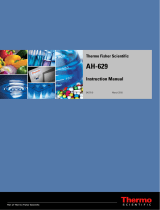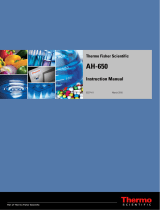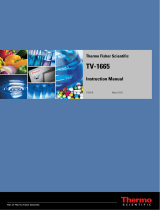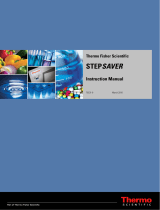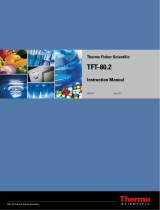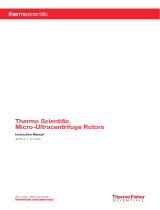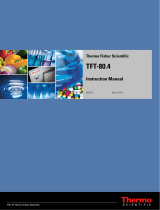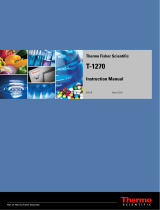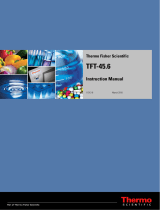Page is loading ...

8242-13 March 2012
Thermo Fisher Scientific
TH-641
Instruction Manual

© 2009 Thermo Fisher Scientific Inc. All rights reserved.
All other trademarks are the property of Thermo Fisher Scientific Inc. and its subsidiaries.
Thermo Fisher Scientific Inc. provides this document to its customers with a product purchase to use in the
product operation. This document is copyright protected and any reproduction of the whole or any part of this
document is strictly prohibited, except with the written authorization of Thermo Fisher Scientific Inc.
The contents of this document are subject to change without notice. All technical information in this
document is for reference purposes only. System configurations and specifications in this document supersede
all previous information received by the purchaser.
Thermo Fisher Scientific Inc. makes no representations that this document is complete, accurate or error-
free and assumes no responsibility and will not be liable for any errors, omissions, damage or loss that might
result from any use of this document, even if the information in the document is followed properly.
This document is not part of any sales contract between Thermo Fisher Scientific Inc. and a purchaser. This
document shall in no way govern or modify any Terms and Conditions of Sale, which Terms and Conditions of
Sale shall govern all conflicting information between the two documents.
Release history: 8242-13 printed in March 2012.
For Research Use Only. Not for use in diagnostic procedures.

Thermo Scientific TH-641 i
T
Thermo Scientific TH-641 Titanium Swinging Bucket Ultraspeed Centrifuge Rotor .. ii
Important Safety Information ................................................................................................. iii
Chapter 1 DESCRIPTION ........................................................................................................................ 1-1
Rotor Description .................................................................................................... 1-2
Rotor Specifications ................................................................................................. 1-2
Accessories ............................................................................................................... 1-3
Chapter 2 OPERATION ............................................................................................................................ 2-1
Prerun Safety Checks ............................................................................................... 2-2
Compartment Loads in Excess of Design Mass ........................................................ 2-2
Critical Speed .......................................................................................................... 2-3
Rotor Precool .......................................................................................................... 2-3
Relative Centrifugal Force (RCF) Determination .................................................... 2-3
Calculation of Sedimentation Time in Aqueous (Non-gradient) Solutions .............. 2-5
Calculation of Sedimentation Time in Gradient Solutions ...................................... 2-6
Chemical Compatibility .......................................................................................... 2-8
Tube Filling and Bucket Loading ............................................................................ 2-9
Rotor Balancing ..................................................................................................... 2-10
Rotor Installation ................................................................................................... 2-11
Centrifuge/Rotor Log Book ................................................................................... 2-12
Chapter 3 CARE and MAINTENANCE ................................................................................................... 3-1
Corrosion ................................................................................................................ 3-2
Cleaning .................................................................................................................. 3-2
Cleaning Swinging Bucket Rotors ............................................................................ 3-3
Storage ..................................................................................................................... 3-4
Inspection ................................................................................................................ 3-4
Overspeed Decal Replacement ................................................................................. 3-4
Service Decontamination Policy .............................................................................. 3-5
Chemical Compatibility Chart ...............................................................................A-1
Contact Information ................................................................................................B-1
Table of contents

Table of contents
ii TH-641 Thermo Scientific

Thermo Scientific TH-641 ii
P
This manual is a guide for the use of
Thermo Scientific TH-641 Titanium Swinging
Bucket Ultraspeed Centrifuge Rotor
Data herein has been verified and is believed adequate for the intended use of the rotor. Because failure
to follow the recommendations set forth in this manual could produce personal injury or property
damage, always follow the recommendations set forth herein. Thermo Fisher Scientific does not
guarantee results and assumes no obligation for the performance of rotors or other products that are
not used in accordance with the instructions provided. This publication is not a license to operate
under, nor a recommendation to infringe upon, any process patents.
Publications prior to the Issue Date of this manual may contain data in apparent conflict with that
provided herein. Please consider all data in this manual to be the most current.
WARNING, CAUTION, and NOTE within the text of this manual are used to emphasize important
and critical instructions.
WARNING informs the operator that injuries or material damage or contamination could occur.
CAUTION informs the operator that material damage could occur.
NOTE highlights essential information.
© 1984,1997, 1999, 2003, 2008, 2010 by Thermo Fisher Scientific
CAUTION and WARNING are accompanied by a hazard symbol and appear near the
information they correspond to.

P
iii TH-641 Thermo Scientific
Important Safety Information
Certain potentially dangerous conditions are inherent to the use of all centrifuge rotors. To ensure safe
operation of this rotor, anyone using it should be aware of all safe practices and take all precautions
described below and throughout this manual.
WARNING
When using radioactive, toxic, or pathogenic materials, be aware of all characteristics of
the materials and the hazards associated with them in the event leakage occurs during
centrifugation. In the event of a rotor failure, neither the centrifuge nor the rotor can
protect you from particles dispersed in the air. To protect yourself, we recommend
additional precautions be taken to prevent exposure to these materials, for example, use of
controlled ventilation or isolation areas.
Always be aware of the possibility of contamination when using radioactive, toxic, or
pathogenic materials. Take all necessary precautions and use appropriate decontamination
procedures if exposure occurs.
Never use any material capable of producing flammable or explosive vapors or creating
extreme exothermic reactions.
Never exceed the maximum rated speed of the installed rotor. To do so can cause rotor
failure.
Always reduce (derate) rotor speed as instructed in this manual whenever:
•the rotor speed/temperature combination exceeds the solubility of the gradient
material and causes it to precipitate.
•the compartment load exceeds the maximum allowable compartment load specified
(average fluid density is greater than 1.7 g/ml). See “Compartment Loads in Excess of
Design Mass” on page 2-2.
Failure to reduce rotor speed under these conditions can cause rotor failure.

P
Thermo Scientific TH-641 iv
CAUTION
Do not expose the aluminum rotor components to: strong acids, bases, or alkaline
laboratory detergents, liquid chlorine bleach, or salts (chlorides) of heavy metals such as
cesium, lead, silver, or mercury. Use of these materials with aluminum can cause a
chemical reaction that initiates corrosion.
Do not operate or precool a rotor at the critical speed, as this will have a detrimental effect
on centrifuge component life. See “Critical Speed” on page 2-2.
Do not operate the rotor unless it is symmetrically balanced as described in this manual.
Operating the rotor out of balance can cause damage to the centrifuge drive assembly.
Always maintain the rotor in the recommended manner. The rotor accessories must be
clean and inspected prior to each run: do not use rotors showing signs of corrosion or
cracking. See “CARE and MAINTENANCE” on page 5-1.
Do not autoclave or expose any aluminum rotor parts to temperatures in excess of 121°C.

P
vTH-641 Thermo Scientific

Thermo Scientific TH-641 1-1
1
RUN PREPARATION
This chapter contains the information necessary to prepare a TH-641 Rotor for operation and includes
important safety information.
Contents
•“Rotor Description” on page 1-2
•“Rotor Specifications” on page 1-2
•“Accessories” on page 1-3

1 RUN PREPARATION
Rotor Description
1-2 TH-641 Thermo Scientific
This manual contains information required to operate and maintain the Thermo Scientific TH-641
Swinging Bucket Ultraspeed Centrifuge Rotor. If you require additional information regarding
operation or maintenance, please contact Thermo Fisher Scientific for assistance. Contact the nearest
Thermo Fisher Scientific office (see Appendix C: “Contact Information” ) or your local representative
for Thermo Fisher Scientific products. Thermo Fisher Scientific product information is available on
our internet web site at http:// www.thermo.com .
Rotor Description
The TH-641 Rotor is a titanium swinging bucket ultracentrifuge rotor that can produce up to six sets
of data during a single run at speeds up to 41,000 rpm1. Each rotor bucket will hold a centrifuge tube
having a nominal fluid capacity of 13.2 ml. The buckets are sealed during operation by a gasket and an
aluminum bucket cap. The buckets are attach to the rotor body, each at its own numbered position.
During a centrifuge run, the buckets swing out horizontally and return to a vertical position during
deceleration. A disc with alternative black and reflective segments attach to the bottom of the rotor
provides overspeed protection.
Rotor Specifications
1Speed in revolutions per minute (rpm) is related to angular velocity, w, according to the following:
Where w = rad/s. All further references in this manual to speed will be designated as rpm.
ω(rpm)=
2π
60
------
rpm()0.10472()=
Table 1-1.Rotor Specifications
Rotor Type Swinging Bucket
Maximum Speed (rpm) 41,000*
*With tubes filled with a homogenous solution having an average density of 1.2 g/ml or less.
Relative Centrifugal Force (RCF) at Maximum Speed
- at rmaximum 15.32 cm 287,660
- at raverage 11.255 cm 211,333
- at rminimum 7.19 cm 135,005
K Factor at Maximum Speed 114
Critical Speed 3450 rpm
Number of Buckets 6
Bucket Capacity (Nominal) 13.2 ml**
**Tube capacity is 11.3 ml with tubes filled to 2 mm to 3 mm of the top.
Total Rotor Capacity (Nominal) 79.2 ml**
Tube Compartment Diameter 14 mm (0.5625 inches)
Tube Compartment Length (Nominal) 89 mm (3.50 inches)
Maximum Compartment Mass 16.4 g
Rotor Diameter 18.28 cm (7.2 inches)
Rotor Weight 5.6 kg (12.3 lbs)

1 RUN PREPARATION
Accessories
Thermo Scientific TH-641 1-3
Accessories
The accessories that are supplied with the TH-641 Rotor, Catalog No. 54295 are listed in Table 1-2.
The only tool that is not supplied with the rotor but is required to tighten the bucket caps is a standard
screwdriver. This item can be ordered from Thermo Fisher Scientific, if desired. The catalog number
for the screwdriver is PN 63112.
To order replacement parts or accessories, contact your local representative for Thermo Fisher Scientific
products. Be sure to provide the catalog number and description of the item required, along with the
rotor name and serial number when ordering
Table 1-2. Accessories Supplied
Quantity Catalog Number Description
1 set of 6 08225 Titanium Rotor Buckets*
*The TH-641 Rotor is supplied with a set of six buckets. Upon opening this set of buckets, you may notice inconsistencies in the surface
finish around the top of the buckets (some buckets may have a silver polished finish and others a grey painted finish). To ensure proper
balance within each set of buckets, Sorvall machines the top of the bucket(s) as required. It is during this machining process that some
of the paint is removed accounting for the inconsistencies in surface finish. This will not effect the performance nor corrosion resistance
of the buckets.
1 52243 Bucket Stand
1 51942 Rotor Stand
1 51353 Overspeed Decal, 41,000 rpm (extra)
1 65937 Vacuum Grease
1 set of 6 08232 Gaskets, Viton® (for rotor buckets)
1 61556 Lubricating Grease
1 08242 Instruction Manual
1 52384 Ultraspeed Centrifuge/Rotor Log Book

1 RUN PREPARATION
Accessories
1-4 TH-641 Thermo Scientific

Thermo Scientific TH-641 2-1
2
SPECIAL CONSIDERATIONS
This chapter contains the information necessary to prepare the TH-641 Rotor for operation and
includes important safety information.
Contents
•“Compartment Loads in Excess of Design Mass” on page 2-2
•“Critical Speed” on page 2-2
•“Relative Centrifugal Force (RCF) Determination” on page 2-2
•“Calculation of Sedimentation Time in Aqueous (Non-gradient) Solutions” on page 2-3
•“Calculation of Sedimentation Time in Gradient Solutions” on page 2-4
•“Precautions to Prevent Precipitation of Cesium Chloride” on page 2-5
•“Chemical Compatibility” on page 2-7

2 SPECIAL CONSIDERATIONS
Compartment Loads in Excess of Design Mass
2-2 TH-641 Thermo Scientific
Compartment Loads in Excess of Design Mass
The maximum run speed of the TH-641 Rotor is based on the recommended design mass that has
been established for this rotor, representing the maximum mass that can be carried in each rotor bucket
at top speed. To prevent rotor failure, the total contents of each bucket (including bucket, specimen
and tube) should not exceed the recommended figure unless the rotor speed is reduced proportionately.
Strict adherence to the maximum allowable compartment mass or reduced speed is required to prevent
rotor failure. Observe the WARNING “Important Safety Information” on page P-iii in the front of this
manual.
The design mass for each compartment of the TH-641 Rotor is 16.4 grams at 41,000 rpm. This figure
is based on the use of a thinwall polyallomer tube filled with a liquid at 1.2 specific gravity.
If the actual load of your rotor is greater than the maximum load, use the following formula to
determine the reduced speed:
Critical Speed
The critical speed is that speed at which any rotor imbalance will produce a driving frequency equal to
the resonant frequency of the rotating system (that is, the rotor and the centrifuge drive). At this speed,
the rotor may produce large amplitude vibrations which can be felt in the centrifuge frame. Mass
imbalance will contribute to increased vibration intensity at the critical speed. Avoid operating the
rotor at the critical speed, which is 3450 rpm for the TH-641 Rotor. Operation at the critical speed
will have a detrimental effect on centrifuge component life. Observe the CAUTION on the Safety
Information Page in the front of this manual.
Relative Centrifugal Force (RCF) Determination
Relative centrifugal force (RCF) refers to the force during centrifugation that moves the particulate
outward from the center of rotation. This force is proportional to the radial distance and the square of
the rotor speed. The RCF value, also known as g force, is determined by the following formula:
maximum Speed 41,000
derated Speed 36,000
Reduced Speed maximum Speed maximum load
actual load
-----------------------------------=
CAUTION Do not operate or precool a rotor at the critical speed, as this will have a
detrimental effect on centrifuge component life.
RCF 11.17 (r) rpm
1000
------------
2
=

2 SPECIAL CONSIDERATIONS
Calculation of Sedimentation Time in Aqueous (Non-gradient) Solutions
Thermo Scientific TH-641 2-3
Figure 2-1 shows the minimum, average, and maximum radii of the TH-641. Table 2-1 gives the RCF
value at each radius at speeds from 20 000 rpm to 41,000 rpm (in increments of 500 rpm). The RCF
value at any other speed can be calculated by using the above formula.
Figure 2-2. TH-641 Rotor Radii
Calculation of Sedimentation Time in Aqueous (Non-gradient)
Solutions
The time required to sediment a particle in water at 20°C through the maximum rotor path length
(that is, the distance between rminimum and rmaximum) can be calculated using the equation:
where:
t = sedimentation time in hours
K = the clearing factor for the rotor (defined below)
S20, w = the sedimentation coefficient for the particle of interest in water at 20°C as expressed in
Svedbergs1
when r = the radius in centimeters from the centerline of the rotor to the point in the tube where
RCF value is required
and rpm = the rotor speed in revolutions per minute
Note The radii values given are the actual rotor specifications. These values do not take the
thickness of the tube into consideration.
rmin 7.19 cm
ravg 11.255 cm
rmax 15.32 cm
tK
S20,w
-------------
=

2 SPECIAL CONSIDERATIONS
Calculation of Sedimentation Time in Gradient Solutions
2-4 TH-641 Thermo Scientific
The clearing (or K) factor is defined by the equation:
Where rmaximum and rminimum are the maximum and minimum rotor radii, respectively, and rotor speed
is expressed in rpm.
K factors for the TH-641 Rotor, at speeds from 20,000 rpm to 41,000 rpm (in increments of 500
rpm), have been listed in Table 2-1.
Example: The TH-641 Rotor has a K factor of 114 at the maximum permitted speed (41000rpm). If
the particles to be sedimented have a sedimentation coefficient of 40S, the estimated run
time required at maximum speed will be:
Note that the calculation assumes particles in water at 20°C. If the suspending medium is denser or
more viscous than water, the sedimentation time will be greater.
Calculation of Sedimentation Time in Gradient Solutions
The time required to sediment a particle through a 5% - 20% (w/w) sucrose density gradient at 5°C
can be calculated using the following formula:
where:
t = sedimentation time in hours
K = the clearing factor for the rotor (the value of K' is dependent on the gradient being used, the
temperature of the gradient, and the density of the particle being sedimented).
S20, w = the sedimentation coefficient for the particle of interest in water at 20°C as expressed in
Svedbergs1
Table 2-2 gives K factors for the TH-641 Rotor when operated at maximum speed (that is, 41,000
rpm) with particles ranging in density from 1.1 g/cm3 to 1.9 g/cm3. The K factors are based on the use
of a 5% - 20% (w/w) linear sucrose density gradient at 5°C.
1 The sedimentation coefficient (S) in seconds, for a particle in a centrifugal field is defined by the equation S =
(dx/dt) [1/( ω2x)]. Where dx/dt = sedimentation velocity of the particle in cm/s. ω = rotor speed in rad/s, and x =
the distance of the particle from the axis of rotation in centimeters. Conventionally, experimentally determined
values of sedimentation coefficients are multiplied by 1013 to convert them to Svedberg units (S), so a particle
with an experimentally determined sedimentation coefficient of 10-11 seconds is usually referred to in the
literature as a "100 S particle." Since the value determined for the sedimentation coefficient is dependent on the
density and viscosity of the solution in which centrifugation is performed, values are usually reported for the
standard conditions of infinite dilution in water at 20°C, and designated S20, w.
K 253000()In rmaximum
rminimum
--------------------
rotor speed
1000
-------------------------
2
÷=
t114
40S
---------
=
2.85 hours 2 hours, 51 minutes=
Table 2-5. K Factor for the TH-641 Rotor (at maximum speed)
Particle Density (g/cm3) K Factor
1.1 792
1.2 420
tK
S20,w
-------------
=

2 SPECIAL CONSIDERATIONS
Precautions to Prevent Precipitation of Cesium Chloride
Thermo Scientific TH-641 2-5
Precautions to Prevent Precipitation of Cesium Chloride
Observe the WARNING on reducing rotor speed found on the Safety Information Page in the front of
this manual.
The maximum speed must be reduced for an average fluid density greater than 1.2 g/ml (square root
reduction) to prevent excessive hydraulic pressure in a bucket. Although the standard formula (see
Compartment Loads in Excess of Design Mass, page 2-2) pertains to sucrose and similar gradient
materials, it will not prevent precipitation of heavy crystals when material such as cesium chloride
(CsCl) is used in an ultracentrifuge. When solid, crystalline CsCl forms, it places a density of 4 g/ml at
the bottom of each bucket. This density is dangerously high and can cause the rotor to fail, with
subsequent sample loss. Therefore, cesium chloride solutions must be run at a reduced speed to avoid
this precipitation.
The allowable speed is determined by the average density of the CsCl solution and the run
temperature. Figure 2-2 should be used to determine the maximum operating speed. Curves are given
for specific average densities and various percentage fills at 4°C and 20°C that will prevent both
precipitation and excessive hydraulic pressure. Also, figure 2-2 includes a curve that shows the standard
speed (square root) reduction to avoid excessive hydraulic pressure only. The standard, square root
reduction formula cannot be used when precipitation of CsCl must be considered. For example,
standard speed reduction would allow densities up to 1.56 g/ml at 36,000 rpm for a full tube. The
dashed line for a full tube shows that precipitation will occur at this speed when the average density is
higher than 1.28g/ml at 4°C.
The Gradient Shape
The curves in figure 2-3 show the gradient shape at equilibrium for tubes filled with CsCl solution,
using the average density and speed selected from figure 2-2. The shape of a gradient produced in a
partially-filled tube can be determined by using the lines shown for 3/4, 1/2 and 1/4 fills. For example,
figure 2-2 indicates that a tube filled with a 1.5g/ml homogeneous CsCl solution cannot be run any
faster than 25,000 rpm at 4°C. Figure 2-3 illustrates the gradient profile of this tube, 1.30g/ml at the
meniscus to 1.81g/ml at the bottom of the tube. The same solution, 1.5g/ml, can be run at 28 500 rpm
in a 3/4-filled tube. The shape of the gradient curve from figure 2-3 can be interpolated between the
1.3 372
1.4 353
1.5 341
1.6 334
1.7 329
1.8 325
1.9 322
Table 2-5. K Factor for the TH-641 Rotor (at maximum speed)
Particle Density (g/cm3) K Factor

2 SPECIAL CONSIDERATIONS
Precautions to Prevent Precipitation of Cesium Chloride
2-6 TH-641 Thermo Scientific
25,000 rpm curve and the 30,000 rpm curve. This interpolation gives a gradient profile from
approximately 1.28g/ml at the top of the gradient to 1.81g/ml at the bottom of the tube. In a
half-filled tube, this solution can be run at 33,000 rpm and a 1/4-filled tube at 41,000 rpm.
Figure 2-3. CsCl Precipitation Curves for the TH-641 Rotor
Note The top portion of the fluid column in a partially-filled tube is assumed to have an overlay of
1.0g/ml density of less. (Polyallomer tubes must be filled to within 3mm of the top to prevent the
tube from collapsing during centrifugation.)
HOMOGENEOUS DENSITY (g/ml)
1.90
1.80
1.70
1.60
1.50
1.40
1.30
1.20
1.10
1.00 ROTOR SPEED (rmp x 1000)
= 20°C
= 4°C
= square-root formula
= example for maximum operating
speed (see CRITICAL SPEED)
= example for gradiant shape
(see page 2-7)
Each square on the grid represents 0.010 g/ml or 500 rpm
Precipation will not occur when both density and rotor speed are below
and to the left of the curve corresponding to the density of CsCl in tube.

2 SPECIAL CONSIDERATIONS
Chemical Compatibility
Thermo Scientific TH-641 2-7
Figure 2-4. CsCl Gradient at Equilibrium
Chemical Compatibility
The critical components of the TH-641 Rotor apt to come in contact with solution are: rotor body and
buckets (titanium) bucket caps (aluminum), gaskets (Viton®), plus the material of the tubes (or bottles)
being used.
1.90
1.80
1.70
1.60
= 20°C
= 4°C
= example of 28,500 rpm
= example for gradient shape
interpolation(see page 2-7)
(see page 2-7)
Each square on the grid represents 0.010 g/ml or 1.00 mm
1.50
1.40
1.30
1.20
1.10
1.00
DENSITY (g/ml)
70 80 90 100 110 120 130 140 150
RADIUS (mm)88.8
67.6 131.2 152.4
Full 3/4 Full 1/4 Full
1/2 Full
rmax
rmin

2 SPECIAL CONSIDERATIONS
Chemical Compatibility
2-8 TH-641 Thermo Scientific
The chemical compatibility of rotor elements and accessory materials is given in the Appendix. Because
no organized chemical resistance data exists for materials under the stress of centrifugation, this data is
intended to be used only as a guide. When in doubt, we recommend pretesting of sample lots.
/
